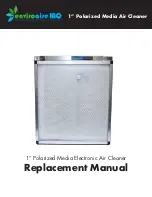
CyberOne EC DX IOM Manual
Supply air outlets return inlets and the rear ducted return are
provided with flanges for connection of the ducting. Refer to
the installation drawing provided with the unit. The connection
of ductwork to the A/C unit may be made with either pop rivets
or self-tapping screws.
2.5
Optional Equipment (Field
Installed)
Do not mount any optional equipment on the unit access
doors.
2.5.1
Floor Stand
Install the floor stand directly on the sub-floor on the isolation
pads supplied, ensuring the side with the FRONT label is
facing the same direction as the front of the precision A/C unit
(see Figure 9). Refer to the floor stand assembly drawing for
the dimensions required to cut the raised floor. The optional
floor stand is designed with adjustable feet on all the legs
allowing for leveling and overall height adjustment. Refer to
the floor stand assembly drawing for minimum and maximum
height adjustability of your floor stand. To adjust the height,
first loosen the middle hex nuts on each leg. Next, turn the top
hex nuts to raise or lower the floor stand. Once the floor stand
is level and even with the raised floor, lock all feet in place
by tightening the middle hex nuts against the top hex nuts.
Figure 9. Optional Floor Stand Installation
2.5.2
Remote Display
As an option, the
E²
controller display panel may be remote
mounted. For mounting and wiring instructions, refer to the
system drawings and supplemental controller manual sent in
the data package with your unit.
2.5.3
Remote Temperature/Humidity Sensor
The remote temperature/humidity (T/H) sensor must be
located so that it will properly sense the temperature/humidity
conditions to be controlled. The T/H sensor should not be
mounted near a doorway or an area where it would be exposed
to direct sunlight. When locating the sensor, consider the
length of wire to be used. As an option, a 75 ft or 150 ft long
cable may be provided by STULZ. Follow the steps below to
mount the sensor.
Temperature /Humidity Sensor
1.
Remove the cover from the base of the sensor by squeez-
ing it at the top and bottom.
CAUTION
Take care not to damage the exposed temperature/
humidity sensors on the PC board when the cover is
removed. The sensors can be damaged if handled
improperly.
2.
Place the base temporarily against the mounting surface.
3.
Level the base. Mark and drill mounting holes through at
least two of the available slotted holes.
4.
Run a 3-conductor shielded cable through the opening
in the base, then secure the base with screws ensuring
the word TOP on the PC board is oriented upward.
5.
Make the wiring connections. Refer to “Utility Connec-
tions” on page 16 and refer to the wiring diagram
supplied with your unit.
6.
Seal the hole in the wall behind the sensor.
7.
Replace the cover plate on the base.
CAUTION
The sensor can be damaged if handled improperly.
Take care not to damage the exposed temperature/
humidity sensor on the PC board. Do not touch the
sensor as this will affect its accuracy.
12
















































